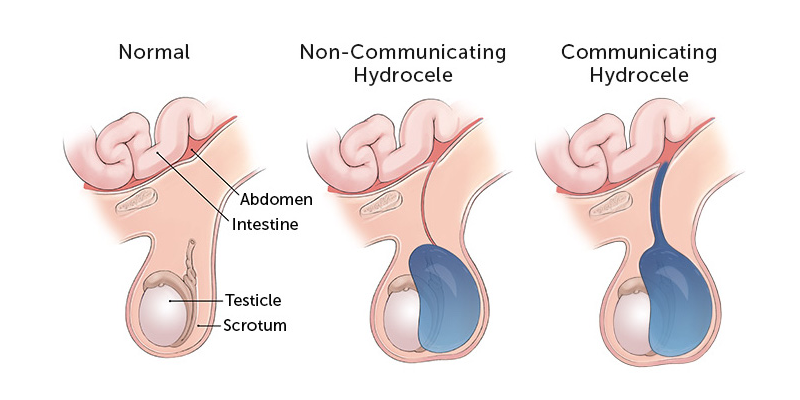Hydrocele: Symptoms, Causes, Treatment
What are the symptoms of a hydrocele?
A hydrocele is a common condition in males, particularly newborns, where fluid builds up in the sac around the testicle, causing swelling. The main symptom of a hydrocele is a painless swelling in the scrotum, which is typically smooth and non-tender. Other symptoms may include:
- Heaviness or dragging sensation in the scrotum.
- Discomfort or pain, particularly when standing for long periods or during physical activity.
- Enlargement of the scrotum, which may vary in size.
- Fluid-filled sac that can be felt in the scrotum.
- Swelling that may be more pronounced at the end of the day or after physical activity.
In infants, a hydrocele may be present at birth or develop within the first few months of life. It often resolves on its own by the age of one without the need for treatment. In adults, a hydrocele may develop due to inflammation or injury within the scrotum, but it can also occur without an obvious cause. If a hydrocele persists or becomes large enough to cause discomfort or embarrassment, it may require treatment by healthcare providers, such as draining the fluid or surgery to remove the hydrocele sac.
What are the causes of a hydrocele?
A hydrocele is usually caused by an imbalance in the production and absorption of fluid in the scrotum, leading to a buildup of fluid around the testicle. There are two main types of hydrocele:
- Communicating hydrocele: This type of hydrocele occurs when there is a defect in the tunica vaginalis, the sac that surrounds the testicle. This defect allows fluid from the abdomen to pass into the scrotum, leading to a hydrocele. Communicating hydroceles are more common in newborns and infants.
- Non-communicating hydrocele: This type of hydrocele occurs when there is no communication between the abdominal cavity and the scrotum. Non-communicating hydroceles are more common in older boys and men and may be caused by inflammation or injury within the scrotum.
Other causes of hydrocele may include:
- Infection or inflammation of the testicle or epididymis (epididymitis).
- Injury to the scrotum.
- Blockage of the spermatic cord.
- Congenital abnormalities.
- Conditions that increase abdominal pressure, such as obesity or heavy lifting.
In many cases, the exact cause of a hydrocele is not known. Hydroceles are more common in newborn males and usually resolve on their own within the first year of life. In older boys and men, hydroceles may persist and may require treatment if they become large or cause discomfort.
What is the treatment for a hydrocele?
The treatment for a hydrocele depends on the size of the hydrocele, the presence of any symptoms, and the underlying cause. In many cases, especially in newborns and infants, a hydrocele may resolve on its own without the need for treatment. However, if a hydrocele persists or causes discomfort, treatment options may include:
- Observation: In many cases, especially in newborns and infants, a hydrocele may be observed without immediate intervention, as it may resolve on its own over time.
- Needle aspiration: If the hydrocele is large and causing discomfort, a healthcare provider may use a needle to drain the fluid from the hydrocele. However, this is usually a temporary solution, as the fluid may reaccumulate.
- Surgery (hydrocelectomy): If a hydrocele persists or recurs, surgery may be recommended to remove the hydrocele sac. This procedure, known as a hydrocelectomy, is usually performed on an outpatient basis and is often successful in preventing the recurrence of the hydrocele.
- Medication: In some cases, medication may be prescribed to reduce inflammation and swelling associated with a hydrocele. However, medication is typically not a primary treatment for hydroceles and is usually used in conjunction with other treatments.
It’s important to note that not all hydroceles require treatment, especially if they are small and asymptomatic. However, if a hydrocele is causing discomfort, is large, or is affecting the blood supply to the testicle, it should be evaluated by a healthcare provider to determine the appropriate treatment approach.




